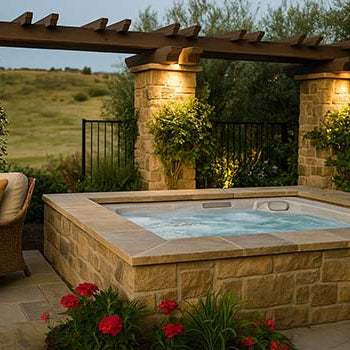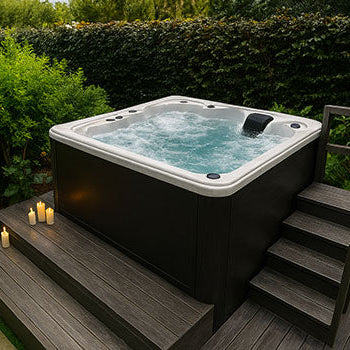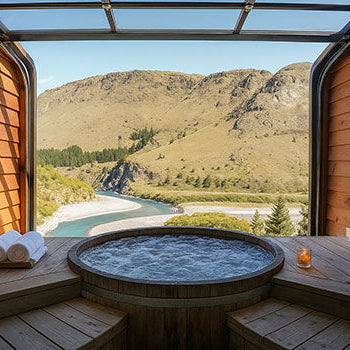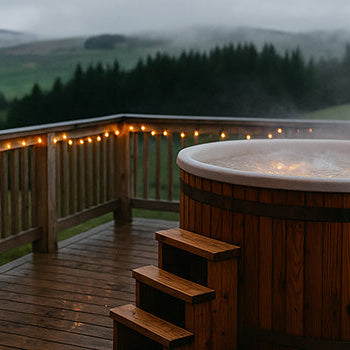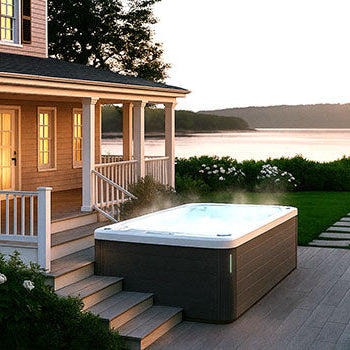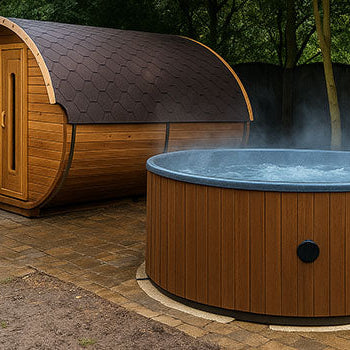Ever wish your hot tub could stick around as long as your Sunday night soak tradition? Most hot tubs last anywhere from 10 to 15 years, but that’s only if they’re properly pampered. Some give up early, especially the budget ones, while others become the heart of your garden for decades. Whether you’ve got an rotomoulded hot tub on a patio, a sleek acrylic spa, or a wooden beauty tucked under the trees, how long it lasts depends on how well it’s made and how you treat it. Keep reading to learn how to make yours last the long haul (and when to start eyeing a replacement).

Average Hot Tub Lifespans: Setting Realistic UK Expectations
Inflatable Hot Tubs: Years vs. Seasons
Inflatable tubs are fun while they last, but don’t expect a lifelong companion. Most only manage 1 to 3 years, especially in the UK where weather swings are brutal. If you baby them a bit (no pets, no sharp zips, cover it daily), they might stretch to five. But realistically, these are built for short-term fun, not forever love.
Rotomolded Hot Tubs: Expected Durability
Rotomoulded tubs are the in-betweeners. Built from tough plastic, they usually give you 8 to 10 years of steady service. Great for families or holiday homes, they’re lighter than traditional models but still pretty tough. As long as they’re not left battling the rain 24/7 without a cover, they hold up well.
Acrylic Hot Tubs: How Quality Impacts Longevity (5 to 20+ Years)
Acrylic tubs are the marathon runners of the spa world. High-quality models can go strong for 15 to even 20 years, if you show them love. Not all acrylic tubs are built the same, though. Some cheaper versions might start showing wear after 6 or 7 years. The secret? Solid framing, insulation, and decent parts beneath the shell.
Key Factors That Dictate Hot Tub Lifespan
Initial Build Quality and Materials (Shell, Frame, Components)
Let’s face it, what’s underneath the shell matters more than the glossy finish. A sturdy frame, durable shell (like acrylic or fibreglass), and quality pumps are what give your tub real staying power. If it feels flimsy or sounds too good to be true, it probably won’t last the decade.
The Non-Negotiable Role of Regular Maintenance
You don’t need to be a hot tub guru, but skipping maintenance altogether? That’s a quick ticket to breakdown city. Clean water, working filters, and weekly TLC are what keep things flowing. Think of it like brushing your teeth, small efforts now prevent big problems later.
Usage Frequency and Intensity
Your hot tub isn’t counting how often you use it, but the wear and tear definitely is. Daily dips for therapy or rowdy weekend gatherings take a toll. The more action it sees, the faster parts wear out, especially filters, jets, and heaters. If it’s constantly running, be ready to replace components sooner.
Environmental Conditions in the UK (Placement, Weather Exposure)
The UK doesn’t exactly offer spa-friendly weather year-round. Constant rain, chilly winters, and blazing sun can age a tub fast. Outdoor tubs need protection, think pergolas, covers, or sheltered corners. Even just shielding it from heavy wind makes a difference over the years.
Consistent Water Chemistry Management
Let the water go rogue and it’ll take the tub down with it. Unbalanced pH or sanitiser levels eat away at seals, damage heaters, and shorten pump life. Checking water chemistry a couple of times a week can mean the difference between a happy tub and a costly disaster.

Recognising the Signs: Is Your Hot Tub Nearing Retirement?
Increasing Frequency and Cost of Repairs
When repair calls become part of your monthly routine, it’s a red flag. Fixing a leak here, a heater there, a pump next month, those costs add up fast. At some point, it’s more sensible to invest in a new tub than keep patching the old one.
Major Leaks or Irreparable Shell Damage
A drip from a loose pipe? Fixable. A big crack in the base or a compromised shell? That’s usually game over. Structural damage is rarely worth repairing and often signals it’s time to say goodbye.
Poor Energy Efficiency and Insulation Failure
If your electric bill starts creeping up or the water never quite heats right, insulation might be failing. Older tubs lose heat faster, meaning more energy gets wasted. You’ll notice it in your wallet before you see it in your spa.
Obsolete Parts and Technology
Trying to find a discontinued pump is like chasing unicorns. If your tub relies on outdated tech or spare parts that no longer exist, you may be stuck with a non-functional spa. Sometimes, it’s better to upgrade than spend months sourcing rare replacements.
Significant Cosmetic Deterioration (Cabinet, Surface)
Looks aren’t everything, but they do count. Faded panels, cracking jets, and stained shells make even a working hot tub feel past its prime. If the spa's condition makes you cringe instead of relax, that’s a sign.
Extending Your Hot Tub's Service Life: Proactive Steps
Why Investing in Quality Pays Off Long-Term
A bargain tub might seem like a steal, until you’re on your third pump in two years. Spending more upfront usually means fewer repairs and better materials, which translates into a longer-lasting spa. It’s a classic case of "you get what you pay for."
Adhering to a Consistent Maintenance Schedule
A routine goes a long way. Test the water regularly, clean filters once a month, and change the water every season. These simple steps can delay breakdowns and keep things running smoothly without drama.
Protecting Your Investment with a Quality Cover
Think of your hot tub cover like a winter coat. A good one traps heat, blocks debris, and shields the shell from UV damage. Cheap, thin covers often sag and crack, costing you more in the long run.
Addressing Minor Issues Before They Escalate
Hear something funny? See a small drip? Fix it now. Tiny issues often snowball into expensive ones if left unchecked. Catching them early can save you hundreds and extend the spa’s life significantly.
The Benefits of Annual Professional Servicing
Bringing in a pro once a year helps spot things you might miss. They can check pump alignment, test electronics, and look for hidden wear. An annual service is like a health check for your hot tub, it keeps things in peak condition.
Lifespan vs. Cost: Evaluating the Investment
A hot tub isn’t just a toy, it’s a commitment. And like most big purchases, it pays to look beyond the price tag. A £6,000 spa that lasts 15 years is a much better deal than a £3,000 one that croaks after five. Think cost per year, not just initial spend.

Conclusion: Planning for Your Hot Tub's Lifespan
At the end of the day, your hot tub’s lifespan boils down to the choices you make. From where you place it, to how often you clean it, to how quick you are to fix the little things, it all adds up. Treat it well, and your spa could be bubbling away happily for well over a decade. Let it slide, and you’ll be shopping for a replacement much sooner than expected. Either way, plan smart and you’ll soak smarter.
